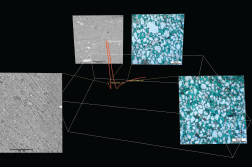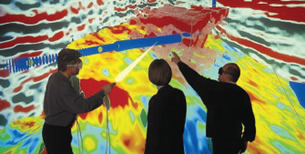The Virtual Perspective
New immersive systems harness the power of virtual reality to enhance design, promote collaboration, and reduce planning time.
Latest News
November 2, 2007
By Tom Kevan
It’s always easier to solve a problem if you can spread all the relevant data out in front of you to get a clear picture of every facet that needs to be considered. And if it’s a team effort, it’s best if everyone can be present, working with the same information, to discuss the various issues and obstacles that must be addressed to arrive at a solution. That’s why most companies have conference rooms and PowerPoint facilities.
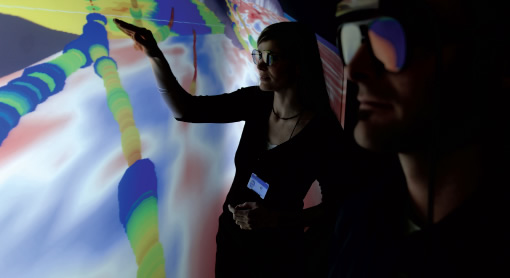 Figure 1: Immersive virtual reality design software developed by Hydro, a Norwegian oil and gas producer, allows drilling engineers, geophysicists, and geologists to become immersed in virtual reality models based on geological and seismic data. |
Whether you are designing an oil well or a car, these well-established practices just make sense. But what if you took this approach one step further? What if you could view the data while walking through the working environment (see Figure 1) — in these cases, the various layers of the earth or the interior or engine compartment of the car? That’s just what immersive virtual reality does.
Immersive Virtual Reality
Working with the Christian Michelsen Research Institute of Fantoft, Norway, a leading offshore oil and gas producer, Hydro — also headquartered in Norway — has developed a suite of immersive virtual reality software tools called Hydro VR. Hydro’s technical staff uses these tools to design, model, and simulate the drilling of wells deep into the earth.
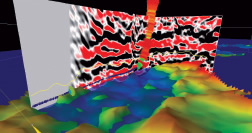 Figure 2: This image shows the base of the Grane oil reservoir (bumpy surface in foreground), with a semi-transparent blue oil-water contact area. The vertical ray shows shale (orange/red disks) and sand after it turns horizontal (small blue discs).Also shown is a seismic section in black andred, with the top of the reservoir drawn with a yellow line. |
|
“The main goal of our software is to simultaneously import and initialize data from many sources so that you don’t need to have different programs displayed at the same time,” says Gunnar Halvorsen, Hydro’s principal engineer. “We can import data from a number of sources, visualize it at the same time, and compare data from different sources.”
To create a virtual environment, the software integrates data provided by several disciplines and sources, including 2D and 3D seismic surveys; well trajectory, well log, and well marker data; reservoir models (see Figure 2); risk management solution models; surface interpretations; core sample images (see Figure 3); oil and gas migration test results; and real-time drilling data.
“We are using traditional applications, which all the other oil companies use, but where we differ is that we take all the results from these different applications and put them into one common view,” says Halvorsen. “We are able to look at them together, and in that way they give value to each other.”
Hydro’s visualization installations consist of single-display walls, usually measuring 2 meters high and 4 or 5 meters wide. The facilities display the images in stereo — a 3D view that enables you to see the depth of the images — using back-projected walls and high-density, high-quality projectors.
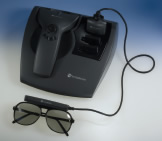 Figure 4: InterSense’s IS-900 Precision Motion Tracking System includes 3D glasses, a head tracker (attached to the top of the glasses), and an interactive wand, which enable realisticinteraction with the computer graphics. |
|
Interacting with the Environment
The technologies that breathe life into the immersive virtual reality of Hydro VR are those that enable users to interact with the environment. These interactive devices are part of the IS-900 Precision Motion Tracking System provided by InterSense, a precision motion-technology company based in Bedford,MA, that delivers real-time positioning, tracking, and aligning capabilities.
The IS-900 consists of a pair of 3D stereo glasses, an inertial-ultrasonic head tracker, an interactive wand, ultrasonic emitters, and a Sensor Fusion Base Unit (see Figure 4) — all of which enable realistic interaction with computer graphics and bring higher speed to visual simulation.
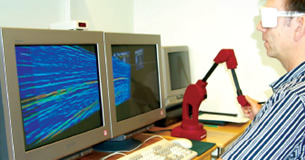 Figure 6: Hydro is taking virtual reality to the desktop.Prototypes include standard PCs, highperformancestereo screens, 3D glasses, and tracking devices. |
The 3D stereo glasses give users the ability to see the 3D environment projected on the wall display. The head tracker snaps onto the top frame of the glasses and contains gyroscopes, accelerometers, and magnetometers. The output from these sensors is then fed to the Sensor Fusion Base Unit’s processor. The processor takes the sensor data, runs tracking algorithms, and calculates the precise position and orientation of the user’s head within millimeters.
This position and orientation data is relayed to the computer that is rendering the image projected on the display screen. The computer translates the users’ head movements into corresponding changes in perspective on the display. When the user moves left or right, the computer essentially redraws the image in the correct perspective.
The wand, or joystick, lets users navigate through a scene. To move through the environment, users push the joystick forward. There are also six buttons on the joystick that let users select or move objects projected on the screen (e.g., slices of earth or segments of drilling pipe). The buttons and the joystick allow users to interact with the virtual environment, much like using a mouse and a cursor.
21st Century Automotive Design The automotive industry was one of the first to take immersive display technology and incorporate it into its design cycle. Before immersive displays were available, automotive engineers used clay models and desktop software to prototype cars. Since their adoption of immersive design systems, automakers have used virtual prototyping early in their development cycles, relying on the large projection systems and interactive interfaces to enhance design reviews and collaboration. These systems allow engineers to work with designs on a one-to-one scale. With immersive technology, they can see if the dashboard or cockpit is ergonomically correct and test in real time the placement of features and instruments. The systems offer a level of flexibility that allows engineers to modify a design, see how it looks and works, and refine it, throw it away, or embrace it. The bottom line is that immersive design systems help automotive engineers reduce design time. —TK |
“We are creating a virtual environment, and the user is interacting with this environment,” says Mike Donfrancesco, one of the chief officers at InterSense. “The tracking system has to be very fast and have very low latency so the image will react in real time with the user’s movement. That is what is required for a successful immersive display — the effective interaction between the user and the data set. The system provides measurement data at a rate of 180 samples per second, with 2 milliseconds of latency and accuracy in the millimeter range.”
Collaboration
In addition to its ability to pull together data from a variety of sources, Hydro VR also provides a meeting place, both actual and virtual, for specialists from a wide range of disciplines.
During the process of designing, modeling, and simulating oil and gas wells, engineers in production, reservoir, and drilling — as well as geologists and geophysicists — can come together in virtual conference rooms (see Figure 5, page 24).
“The idea was to give the various disciplines a meeting ground, where it is easier to explain your data to another discipline, to other professionals, and also to understand the problems you are confronting,” says Halvorsen. “By using this approach, we have managed to arrive at solutions quicker than we would using traditional methods. You improve the common understanding.”
Collaborative sessions can also involve two or more processes, or meetings, tied together, where participants in different geographical locations see the same data. Each location has its own pilot, who controls the display and data from his or her particular location.
This type of collaboration is implemented through the network that connects Hydro’s various offices, from Bergen and Oslo in Norway to Houston,TX. Software called CAVERNsoft collects and distributes the events that the pilot is performing — for instance, where he moves his head or hand, and what buttons he presses — over the network to the participating sites.
Functionality Developed in Hydro VR System Requirements: |
This elegant way of collaborating does not require a super network. “You can work together over very poor networks, where the speed is quite low,” says Jens Grimsgaard, Senior Geophysicist at Hydro. “We have tested it between Houston and Oslo, and it works nicely.”
Moving to the Desktop
In the near future, Hydro will take virtual reality to the desktop. “Our staff wants to use the software as often as possible, or when they need it,” says Grimsgaard. “Often, going to specially equipped rooms is not convenient, and these facilities can handle only limited numbers of people. It is easier to pull up the application on a PC and connect it to other users with their PCs.”
The new systems (see Figure 6, page 24) will have scaled-down but high-performance stereo screens, 3D glasses, and tracking devices. InterSense will provide a new six degrees-of-freedom interface device — a “mouse on steroids” — that you can pick up, rotate, and move around without pressing a button or turning a dial.
Availability
In 2002, Hydro sold its immersive reality software to Schlumberger Information Solutions of Sugar Land, TX, but retained the right to develop it further for in-house use only. A system similar to the one described in this article can be purchased from Schlumberger.
More Information
Christian Michelsen Research Institute
Fantoft, Norway
cmr.no
Hydro
Oslo, Norway
hydro.com
InterSense
Bedford, MA
isense.com
Schlumberger Information Solutions
Sugar Land, TX
slb.com
Tom Kevan is a New Hampshire-based freelance writer specializing in technology. Send your comments about this article to DE-Editorsmailto:[email protected].
Subscribe to our FREE magazine, FREE email newsletters or both!
Latest News
About the Author
DE’s editors contribute news and new product announcements to Digital Engineering.
Press releases may be sent to them via [email protected].







